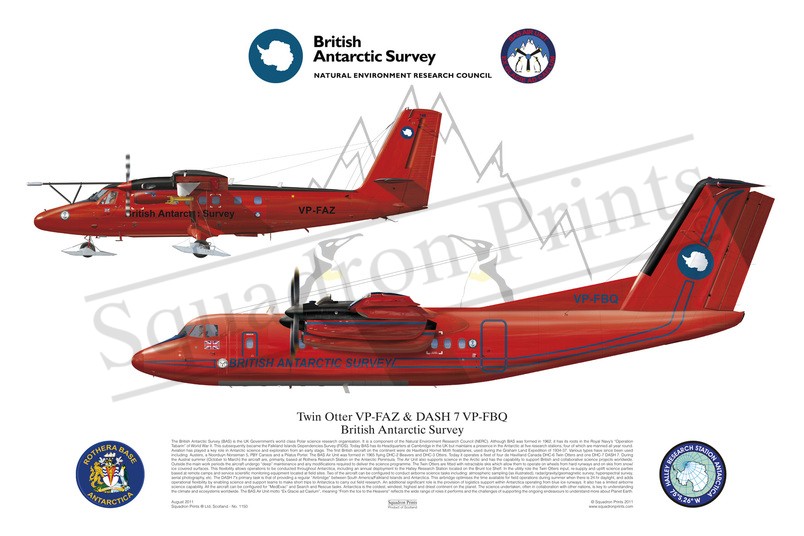#1150 Twin Otter; DASH-7

Purchased products will not feature the Squadron Prints watermark
Description
Squadron Prints Lithograph No. 1150 - Twin Otter VP-FAZ & DASH 7 VP-FBQ, British Antarctic Survey.
The British Antarctic Survey (BAS) is the UK Government’s world class Polar science research organisation. It is a component of the Natural Environment Research Council (NERC). Although BAS was formed in 1962, it has its roots in the Royal Navy’s “Operation Tabarin” of World War II. This subsequently became the Falkland Islands Dependencies Survey (FIDS). Today BAS has its Headquarters at Cambridge in the UK but maintains a presence in the Antarctic at five research stations, four of which are manned all year round. Aviation has played a key role in Antarctic science and exploration from an early stage. The first British aircraft on the continent were de Havilland Hornet Moth floatplanes, used during the Graham Land Expedition of 1934-37. Various types have since been used including: Austers, a Noorduyn Norseman 5, PBY Cansos and a Pilatus Porter. The BAS Air Unit was formed in 1965 flying DHC-2 Beavers and DHC-3 Otters. Today it operates a fleet of four de Havilland Canada DHC-6 Twin Otters and one DHC-7 DASH 7. During the Austral summer (October to March) the aircraft are, primarily, based at Rothera Research Station on the Antarctic Peninsula. The Air Unit also supports science in the Arctic and has the capability to support British and collaborative science projects worldwide. Outside the main work periods the aircraft undergo “deep” maintenance and any modifications required to deliver the science programme. The Twin Otters are fitted with retractable skis which allow them to operate on wheels from hard runways and on skis from snow/ice covered surfaces. This flexibility allows operations to be conducted throughout Antarctica, including an annual deployment to the Halley Research Station located on the Brunt Ice Shelf. In the utility role the Twin Otters input, re-supply and uplift science parties based at remote camps and service scientific monitoring equipment located at field sites. Two of the aircraft can be configured to conduct airborne science tasks including: atmospheric sampling (as illustrated), radar/gravity/geomagnetic survey; hyperspectral survey, aerial photography, etc. The DASH 7’s primary task is that of providing a regular “Airbridge” between South America/Falkland Islands and Antarctica. This airbridge optimises the time available for field operations during summer when there is 24 hr daylight, and adds operational flexibility by enabling science and support teams to make short trips to Antarctica to carry out field research. An additional significant role is the provision of logistics support within Antarctica operating from blue ice runways. It also has a limited airborne science capability. All the aircraft can be configured for “MedEvac” and Search and Rescue tasks. Antarctica is the coldest, windiest, highest and driest continent on the planet. The science undertaken, often in collaboration with other nations, is key to understanding the climate and ecosystems worldwide. The BAS Air Unit motto “Ex Glacie ad Caelum”, meaning “From the Ice to the Heavens” reflects the wide range of roles it performs and the challenges of supporting the ongoing endeavours to understand more about Planet Earth.
You may also like
-
Liberator, Lancaster, Shackleton, Nimrod, P-8A
WG530 'H'; AM917 'OH-F'; XZ280; XV253; ZP801; RF289 'BS-G'120 SqnRAF Aldergrove; RAF Kinloss; RAF Lossiemouth -
Hawk Mk65
8801The Royal Saudi Air Force Aerobatic Team, The Saudi Hawks, 88 SqnTabuk, King Falsal AB
